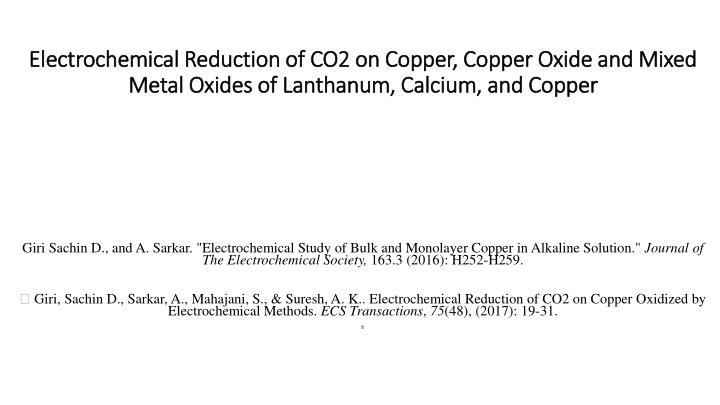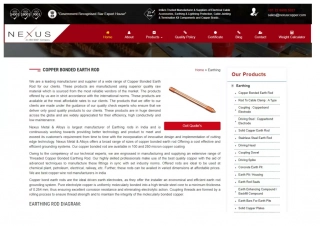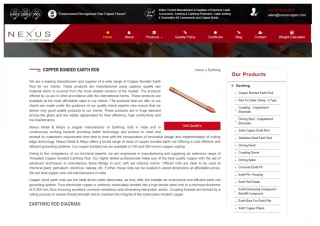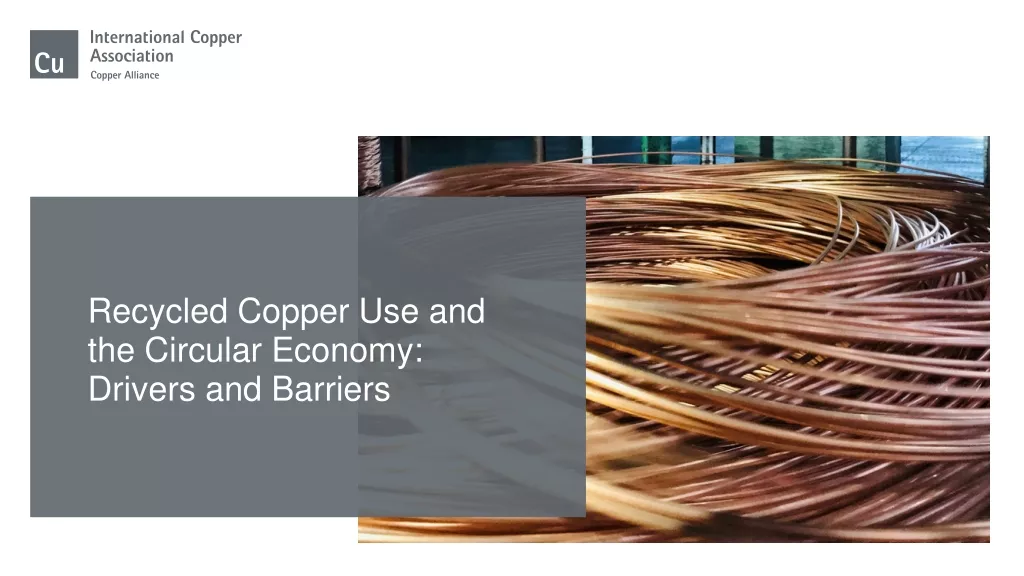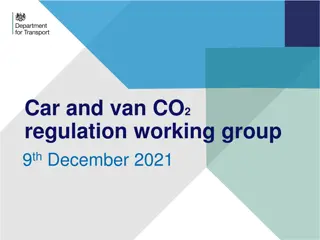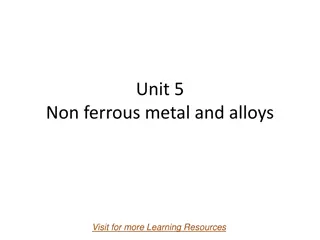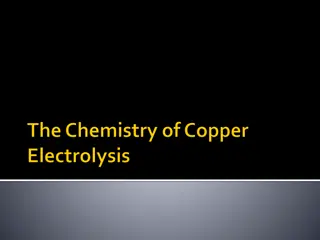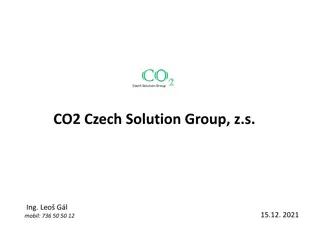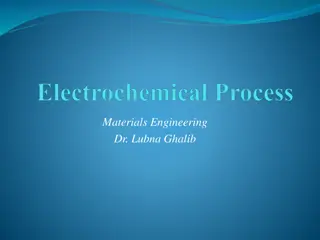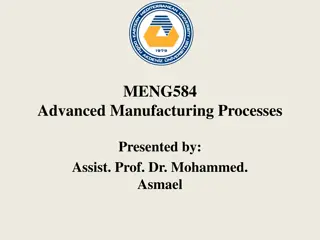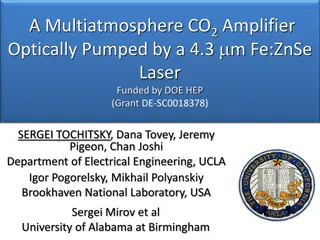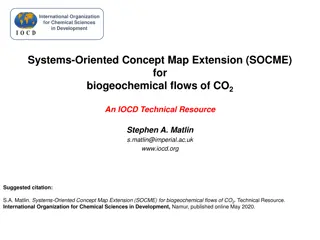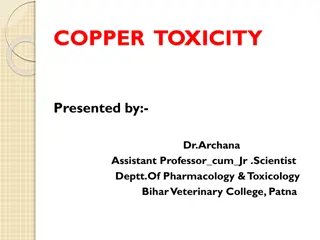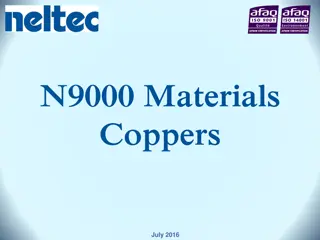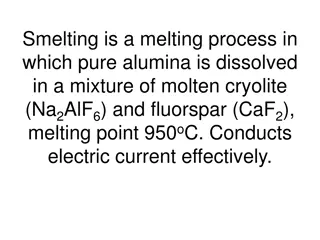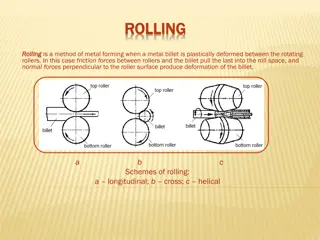Electrochemical Reduction of CO2 on Copper and Mixed Metal Oxides
Different methods for CO2 reduction have been studied, with electrochemical reduction showing promise due to its use of electricity from nonconventional sources. Research on copper's unique characteristics for producing various CO2 reduction products has led to investigations into optimizing activity and selectivity. Comparison of oxidation methods on copper foils reveals differences in electrochemically active surface area and current densities. The study emphasizes the need to lower overpotential in commercial electrochemical CO2 reduction applications.
Download Presentation

Please find below an Image/Link to download the presentation.
The content on the website is provided AS IS for your information and personal use only. It may not be sold, licensed, or shared on other websites without obtaining consent from the author.If you encounter any issues during the download, it is possible that the publisher has removed the file from their server.
You are allowed to download the files provided on this website for personal or commercial use, subject to the condition that they are used lawfully. All files are the property of their respective owners.
The content on the website is provided AS IS for your information and personal use only. It may not be sold, licensed, or shared on other websites without obtaining consent from the author.
E N D
Presentation Transcript
Electrochemical Reduction of CO2 on Copper, Copper Oxide and Mixed Electrochemical Reduction of CO2 on Copper, Copper Oxide and Mixed Metal Oxides of Lanthanum, Calcium, and Copper Metal Oxides of Lanthanum, Calcium, and Copper Giri Sachin D., and A. Sarkar. "Electrochemical Study of Bulk and Monolayer Copper in Alkaline Solution." Journal of The Electrochemical Society, 163.3 (2016): H252-H259. Giri, Sachin D., Sarkar, A., Mahajani, S., & Suresh, A. K.. Electrochemical Reduction of CO2 on Copper Oxidized by Electrochemical Methods. ECS Transactions, 75(48), (2017): 19-31.
Different methods for CO2 reduction to useful chemicals and fuels has been studied and reported in the literature. Electrochemical method for the CO2 reduction seems to be more promising due to the direct use of the electricity generated by nonconventional sources of the energy. Further, electrochemical reduction of CO2 has been studied in aqueous and non aqueous solution by using different metal electrodes. Literature for many metals used for the electrochemical reduction of the CO2 as electrocatalyst and the product of the reduction are available. The major disadvantage of the electrochemical method is a requirement of high overpotential for CO2 reduction and the parallel HER. To make commercial use of the electrochemical reduction of the CO2 to produce important chemicals and fuel, the overpotential need to be lowered in addition to increase the selectivity of the catalyst toward commercially important chemical compared to the hydrogen evolution.
The unique characteristic of the copper to produce hydrocarbon, carboxylic acid, aldehydes/ketones and alcohols as CO2 reduction products has persuaded many researchers to investigate the effects of different parameters on the activity and selectivity of copper for electrochemical reduction of the CO2
The comparison between the oxidation method for the activity for CO2 reduction shows that the copper foil oxidized by the annealing produces a thick layer of oxides on copper foil compared to the anodized copper foil. This thick layer of oxides upon reduction results in the higher electrochemically active surface area as compared to the anodized copper foil. Further, the higher EASA for annealed copper foil manifests as higher currents due to electrochemical reduction of CO 2 is more than that obtained for the anodized copper. Meanwhile, with an increase in the reduction potential, the difference between the reduction current densities of anodized and annealed copper foil decreases drastically.
However, the selectivity of the formate ion formation from electrochemical CO2 reduction increases with the pretreatment/activation (oxidation in air or electrochemical followed by the reduction while reducing CO2 electrochemically). Further, a comparison of the selectivity, manifested by faradaic efficiency, for the formation of formate ion between anodized and annealed copper reveals that anodization of copper is more effective than annealing.
Different methods for CO2 reduction to useful chemicals and fuels has been studied and reported in the literature. Electrochemical method for the CO2 reduction seems to be more promising due to the direct use of the electricity generated by nonconventional sources of the energy. Further, electrochemical reduction of CO2 has been studied in aqueous and non aqueous solution by using different metal electrodes. Literature for many metals used for the electrochemical reduction of the CO2 as electrocatalyst and the product of the reduction are available. The major disadvantage of the electrochemical method is a requirement of high overpotential for CO2 reduction and the parallel HER. To make commercial use of the electrochemical reduction of the CO2 to produce important chemicals and fuel, the overpotential need to be lowered in addition to increase the selectivity of the catalyst toward commercially important chemical compared to the hydrogen evolution.
Cyclic voltammogram of copper in 0.5 M Na2CO3 solution shows a different signature than that of in 0.5 M KOH solution. The shape, as well as the charge under peaks, is less than that observed in the CV of 0.5 M KOH. The reason for the less oxidation charge may be the formation of a passive oxide layer produced due to the interaction with carbonate ions present in the solution. Cyclic voltammogram of copper in 0.5 M NaHCO3 solution shows slightly different signature than that of either 0.5 M KOH or 0.5 M Na2CO3. In case of 0.5 M NaHCO3 solution also, the peak current increase with scan rate in studied potential scan rate unlike 0.5 M KOH.
surface area of the copper powder was estimated by using SEM (scanning electron microscopy), particle size analyzer, optical microscopy and BET (Brunauer-Emmett-Teller), etc. These methods will also give further validation to the surface area estimated by the electrochemical methods. The surface area estimation using electrochemical methods is very fast (within few minutes) compared to few hours required for the BET analysis. Further, the specialized machine used in case of BET, SEM is not required in the electrochemical method. Moreover, these methods will fail in estimating surface area if copper is monolithic or supported on carbon or some other material. The electrochemical method can be used for monolithic copper as well as supported copper as long as the support is conductive. Further, the requirement of solvents and chemicals is minimum. If the electrochemical methods protocols are fixed, then it can be used for the estimation of the surface area instead of the other methods
Subsequent reduction of the final products of oxidation proceeds in two stages (i) initially only a fraction of CuO gets reduced to metallic Cu (under peak C) and (ii) the rest of oxidized species gets reduced at a still lower potential (under peak D). The CV of monolayer copper deposited on platinum confirms the formation of Cu(I) oxides (Cu2O) as potential moved towards positive potential. It was further confirmed form the oxidation charge calculations for Cu2O. The dissolution of monolayer copper indeed takes place, but at significantly higher potential and only a fraction of Cu2O reacts further to Cu(OH)2. This suggests that the underlying platinum layer imparts a degree of nobility to copper monolayer with nitial stages of oxidation of copper seem to mimic that for bulk copper; the onset potential is significantly higher. Cyclic voltammogram of copper in 0.5 M Na2CO3 solution shows a different signature than that of in 0.5 M KOH solution. The shape, as well as the charge under peaks, is less than that observed in the CV of 0.5 M KOH. The reason for the less oxidation charge may be the formation of a passive oxide layer produced due to the interaction with carbonate ions present in the solution. Cyclic voltammogram of copper in 0.5 M NaHCO3 solution shows slightly different signature than that of either 0.5 M KOH or 0.5 M Na2CO3. In case of 0.5 M NaHCO3 solution also, the peak current increase with scan rate in studied potential scan rate unlike 0.5 M KOH.
The electrochemical characterization of the bulk and monolayer copper in alkaline solution has revealed many aspects of the copper oxide formation and their subsequent reduction. The observations and conclusions summarized : The Cu2O produced by initial oxidation of copper results in the formation of a monolayer film for certain range of scan rate and pH. The formation of this monolayer appears as peak A. Upon increasing the potential, copper atoms oxidizes to form Cu(OH)2 along with water soluble ( Cu(OH)2 4 ) oxide. As the potential is increased further the formation of CuO takes place. The formation of these oxides of copper (Cu2+) appears as peak B. The shape of the peak A is independent of the scan rate. However, in case of peak B, the shape changes significantly. Charge under both peaks (A and B) increases as the scan rate of CV decreases below 30 mV/s. The SEM images of the electrochemically oxidized copper foils by LSV below 30 mV/s scan rate indicates the formation of needle-like structures which might explain the atypical relation between the peak currents and scan. Voltammetry data suggest that the final product of oxidation is a mix of Cu2O, CuO, and Cu(OH)2. This has been verified further by XPS analysis of the oxidized copper foils. Subsequent reduction of the final products of oxidation proceeds in two stages (i) initially only a fraction of CuO gets reduced to metallic Cu (under peak C) and (ii) the rest of oxidized species gets reduced at a still lower potential (under peak D). The CV of monolayer copper deposited on platinum confirms the formation of Cu(I) oxides (Cu2O) as potential moved towards positive potential. It was further confirmed form the oxidation charge calculations for Cu2O. The dissolution of monolayer copper indeed takes place, but at significantly higher potential and only a fraction of Cu2O reacts further to Cu(OH)2. This suggests that the underlying platinum layer imparts a degree of nobility to copper monolayer with respect to oxidation. The initial stages of oxidation of copper seem to mimic that for bulk copper; the onset potential is significantly higher.
Cyclic voltammogram of copper in 0.5 M Na2CO3 solution shows a different signature than that of in 0.5 M KOH solution. The shape, as well as the charge under peaks, is less than that observed in the CV of 0.5 M KOH. The reason for the less oxidation charge may be the formation of a passive oxide layer produced due to the interaction with carbonate ions present in the solution. Cyclic voltammogram of copper in 0.5 M NaHCO3 solution shows slightly different signature than that of either 0.5 M KOH or 0.5 M Na2CO3. In case of 0.5 M NaHCO3 solution also, the peak current increase with scan rate in studied potential scan rate unlike 0.5 M KOH.
Electrochemical Reduction of the CO2 on Electrochemically Oxidized Copper Foil The electrochemical reduction of the CO2 was carried out on copper foil oxidized by CA, LSV and CV in CO2 purged 0.5 M NaHCO3 solution. The electrochemical oxidations of the copper foils were carried out in 0.5 M KOH solution. The important observations and conclusions have been summarized below: The electrochemical oxidation by these methods results in the formation of oxide film consisting of Cu2O, CuO, and Cu(OH)2. The XPS analysis shows that the oxides produced on the copper surface by electrochemical methods get reduced back to copper in first few minutes when oxidized copper foil subjected to the CO2 reduction (at -1.6 V). Further, the spectrophotometric analysis of the reduced copper foils has also been used to corroborate the reduction of the copper oxides back to copper. The SEM images also show that the oxides needles go to extinction within five minutes of the CO2 reduction. It has been conclusively demonstrated that the electrochemical reduction takes place on copper and not on the oxides of copper. The CO2 reduction current density of the oxidized copper foils was significantly higher than un-oxidized copper foil. The copper oxidized by CV shows highest current density followed by LSV and then by CA oxidized copper foils. The reason of the increase in the current density was increase in the surface roughness/real surface area/EASA (measured by UPD of Pb) due to oxidation and subsequent reduction. The oxidation of copper by CV is more intense compared to LSV and CA, hence higher EASA and higher activity for CO2 reduction. This manifests as higher current density by CV as compared to LSV and CA. The selectivity of the formate ions produced due to electrochemical reduction of CO2 increases after oxidation of copper. The highest amount of formate ions was produced on the copper foil oxidized by CV.
Electrochemical Reduction of the CO2 on Electrochemically Oxidized Copper Foil The electrochemical reduction of the CO2 was carried out on copper foil oxidized by CA, LSV and CV in CO2 purged 0.5 M NaHCO3 solution. The electrochemical oxidations of the copper foils were carried out in 0.5 M KOH solution. The important observations and conclusions have been summarized below: The electrochemical oxidation by these methods results in the formation of oxide film consisting of Cu2O, CuO, and Cu(OH)2. The XPS analysis shows that the oxides produced on the copper surface by electrochemical methods get reduced back to copper in first few minutes when oxidized copper foil subjected to the CO2 reduction (at -1.6 V). Further, the spectrophotometric analysis of the reduced copper foils has also been used to corroborate the reduction of the copper oxides back to copper. The SEM images also show that the oxides needles go to extinction within five minutes of the CO2 reduction. It has been conclusively demonstrated that the electrochemical reduction takes place on copper and not on the oxides of copper. The CO2 reduction current density of the oxidized copper foils was significantly higher than un-oxidized copper foil. The copper oxidized by CV shows highest current density followed by LSV and then by CA oxidized copper foils. The reason of the increase in the current density was increase in the surface roughness/real surface area/EASA (measured by UPD of Pb) due to oxidation and subsequent reduction. The oxidation of copper by CV is more intense compared to LSV and CA, hence higher EASA and higher activity for CO2 reduction. This manifests as higher current density by CV as compared to LSV and CA. The selectivity of the formate ions produced due to electrochemical reduction of CO2 increases after oxidation of copper. The highest amount of formate ions was produced on the copper foil oxidized by CV.
Electrochemical Reduction of the CO2 on Anodized and Annealed Copper Foil The electrochemical reduction of the CO2 on anodized (25 cycles of CV at a scan rate of 5 mV/s in Ar saturated 0.5 M KOH solution), annealed (heated at 400 0C for 10 hours in air) and un-oxidized copper in 0.5 M NaHCO3 solution were compared. The important observations and conclusions have been summarized below: The electrochemical oxidation by these method results in the formation of oxide film consisting of Cu2O, CuO, and Cu(OH)2. The thermochemical oxidation results in the formation of Cu2O, CuO, and Cu3O4. The annealing has produced a thicker layer of oxides on copper foil compared to the anodized copper foil. The thick layer of oxides upon reduction results in higher EASA compared to the anodized copper foil. The EASA was measured by UPD of Pb. Due to higher EASA for annealed copper foil, the current density for CO2 reduction is more for the annealed copper. With the increase in reduction potential, the difference between the reduction current density of anodized and annealed copper foils decreases drastically. The selectivity of the formate ion formation due to electrochemical reduction of CO2 ncreases on the oxidized copper foils compared to un-oxidized copper foils. The amount of formate ions produced was highest for copper oxidized by annealing. In contrast, the faradaic efficiency for formate ion formation is higher for copper foil oxidized by anodization. The faradaic efficiency of anodized copper foil was lower than annealed copper foil at -2.0 V may be due to dominating HER at this potential than at lower potentials
Estimation of Copper Powder Surface Area by Electrochemical, Microscopy and Laser Diffraction Methods For determination of the EASA of copper foil after oxidation, UPD of Pb has been used extensively. Here, we have cross checked the accuracy and reliability of the electrochemical method viz UPD of Pb and Cu2O monolayer by comparing the surface area estimated these methods with surface area estimated other methods. Along with electrochemical method, microscopy (optical and scanning electron) and laser diffraction methods have been used. The major observations and conclusion have been summarized below Commercial copper powder with spherical particles and 10 micron size was used for this study. SEM images were captured and used to find the average particle size and using the density of the copper powder, the surface area of the copper powder was estimated. Optical microscopy images were used to estimate the particle size of the copper particle and surface area of the copper powder was determined. Laser diffraction technique has been used to estimate the particle size and then the surface area of the copper powder. The surface area estimated by the electrochemical methods and other methods are in good agreement. The electrochemical method has few more advantages over the conventional surface estimating methods. The electrochemical method can be used for the monolithic as well as supported catalysts where BET or other methods fail. Electrochemical methods can estimate the surface area rapidly compared to the other methods. Further, the requirement of the chemical and equipment is minimum.
Electrochemical Reduction of CO2 to C1 and C2 Carboxylic Acids on Mixed Oxides of Lanthanum, Calcium, and Copper Copper derived from the copper oxides was found to be more active for the electrochemical reduction of CO2. Additionally, the selectivity for the formation of formate ions has been changed significantly after the oxidation. Here, the effect of the presence of the other metal oxides has been investigated. The major observations and conclusions have been ummarized below. The CO2 reduction charges remain fairly constant throughout the experiment suggesting no major surface modification occurred. As the atomic fraction of Ca decreases (La atomic fraction increased), lower reduction charges have been observed. The highest charge at lower potentials (-1.4 V and -1.6 V) was observed for the catalyst CaCu while at higher potentials (-1.8 V and -2.0 V) it was observed for the catalyst La0.6Ca0.4Cu.
The major products produced were formate ions and acetate ions, along with propanol and traces of the butanol. Formate ions have been produced on all the catalyst and at all the potential used for the electrochemical reduction. Amount of formate ions produced is more when the fraction of La was small or zero. The faradaic efficiency for formate ions at -1.6 V to -2.0 V remains fairly constant after first half hour for almost all the catalyst except in few cases. At higher potential CaCu gives highest faradaic efficiency for formate ions at -2.0 V. Very small amount of acetic acid was produced on catalyst when the atomic fraction of calcium is increased from 0.1. The highest quantity of acetic acid has been produced on LaCu electrode at all potentials followed by La0.8Ca0.2Cu. There is a significant difference between the quantities of acetic acid produced by these two catalysts. Among these two catalysts (LaCu and La0.8Ca0.2Cu) the amount of acetic acid produced on LaCu is quite large hence the highest faradaic efficiency of 90.74 % at -1.6 V was observed for LaCu. Due to this high faradaic efficiency for acetic acid formation, LaCu can be seen as a very promising catalyst for the reduction of CO2
